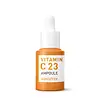What's inside
What's inside
 Key Ingredients
Key Ingredients

 Benefits
Benefits

 Concerns
Concerns

No concerns
 Ingredients Side-by-side
Ingredients Side-by-side

Water
Skin ConditioningAscorbic Acid 23%
AntioxidantPropanediol
SolventAlcohol Denat.
AntimicrobialSodium Citrate
Buffering1,2-Hexanediol
Skin ConditioningPanthenol
Skin Conditioning3-O-Ethyl Ascorbic Acid
Skin ConditioningGlycerin
HumectantOctyldodeceth-16
EmulsifyingButylene Glycol
HumectantGlutathione
Sodium Acrylic Acid/Ma Copolymer
Parfum
MaskingDisodium EDTA
Ferulic Acid
AntimicrobialTocopherol
AntioxidantEthylhexylglycerin
Skin ConditioningAdenosine
Skin ConditioningXanthan Gum
EmulsifyingPiper Methysticum Leaf/Root/Stem Extract
Skin ConditioningHydrogenated Lecithin
EmulsifyingCaprylyl Glycol
EmollientPhellodendron Amurense Bark Extract
Skin ConditioningDextrin
AbsorbentTheobroma Cacao Seed Extract
AntioxidantCitrus Junos Seed Extract
AntioxidantPvp
Emulsion StabilisingFullerenes
AntimicrobialWater, Ascorbic Acid 23%, Propanediol, Alcohol Denat., Sodium Citrate, 1,2-Hexanediol, Panthenol, 3-O-Ethyl Ascorbic Acid, Glycerin, Octyldodeceth-16, Butylene Glycol, Glutathione, Sodium Acrylic Acid/Ma Copolymer, Parfum, Disodium EDTA, Ferulic Acid, Tocopherol, Ethylhexylglycerin, Adenosine, Xanthan Gum, Piper Methysticum Leaf/Root/Stem Extract, Hydrogenated Lecithin, Caprylyl Glycol, Phellodendron Amurense Bark Extract, Dextrin, Theobroma Cacao Seed Extract, Citrus Junos Seed Extract, Pvp, Fullerenes
Ingredients Explained
These ingredients are found in both products.
Ingredients higher up in an ingredient list are typically present in a larger amount.
1,2-Hexanediol is a synthetic liquid and another multi-functional powerhouse.
It is a:
- Humectant, drawing moisture into the skin
- Emollient, helping to soften skin
- Solvent, dispersing and stabilizing formulas
- Preservative booster, enhancing the antimicrobial activity of other preservatives
You might know this ingredient as Ethyl Ascorbic Acid, a more stable version of ascorbic acid.
Like other types of vitamin C, this ingredient has many benefits including reducing wrinkles, skin soothing, dark spot fading, and fighting against free radicals.
3-O-Ethyl Ascorbic Acid interferes with the process of skin darkening, helping to reduce hyperpigmentation. It also encourages the skin to produce more collagen.
Once applied, 3-O-Ethyl Ascorbic Acid is converted to Vitamin C deeper in the skin's layers. This process is slow but makes this ingredient more tolerable for skin.
The optimum pH range for this ingredient is 4 - 5.5
Learn more about 3-O-Ethyl Ascorbic AcidAscorbic Acid is is pure Vitamin C. This form makes up the largest amount of vitamin C found naturally in our skin.
Not only is vitamin C great for your overall health and immune system, it also has plenty of benefits on your skin.
Vitamin C is best used for brightening skin. It improves dark spots, acne scars, and hyperpigmentation. This is because it blocks the process of skin darkening when exposed to UV.
Remember: Vitamin C should not replace sunscreen!
Your skin uses vitamin C to build collagen. Collagen is one key component in having a strong skin barrier and plump skin. Vitamin C also plays a role in regulating collagen, thus making it effective in improving wrinkles and fine lines.
Ascorbic acid shows potent antioxidant activity. As an antioxidant, it helps fight free-radicals. Free-radicals are molecules that may damage your skin cells. These antioxidants also protect skin against UV damage.
The best formulations include Vitamin E and/or ferulic acid. These two ingredients help stabilize and provide a boost in the benefits of ascorbic acid. This is because ascorbic acid becomes unstable when exposed to UV and air. In fact, you can tell your ascorbic acid has oxidized when it turns an orange-yellow color.
Ascorbic acid is generally compatible with other ingredients. However, using ascorbic acid with other active ingredients might cause irritation. Two ingredients: copper ions and benzoyl peroxide, will inactivate ascorbic acid completely.
Read more about other types of Vitamin C:
Foods rich with vitamin C include oranges, strawberries, broccoli, bell peppers, and more. When consuming Vitamin C, your skin receives a portion of the nutrients.
Learn more about Ascorbic AcidButylene Glycol (or BG) is used within cosmetic products for a few different reasons:
Overall, Butylene Glycol is a safe and well-rounded ingredient that works well with other ingredients.
Though this ingredient works well with most skin types, some people with sensitive skin may experience a reaction such as allergic rashes, closed comedones, or itchiness.
Learn more about Butylene GlycolEthylhexylglycerin (we can't pronounce this either) is commonly used as a preservative and skin softener. It is derived from glyceryl.
You might see Ethylhexylglycerin often paired with other preservatives such as phenoxyethanol. Ethylhexylglycerin has been found to increase the effectiveness of these other preservatives.
Propanediol is an all-star ingredient. It softens, hydrates, and smooths the skin.
It’s often used to:
Propanediol is not likely to cause sensitivity and considered safe to use. It is derived from corn or petroleum with a clear color and no scent.
Learn more about Propanediol